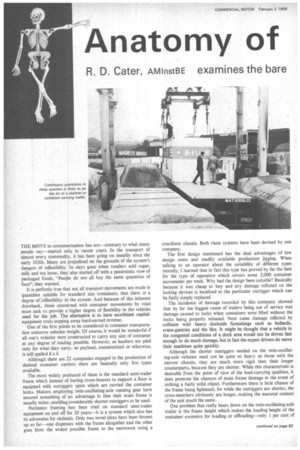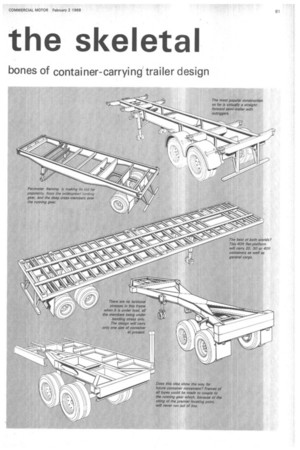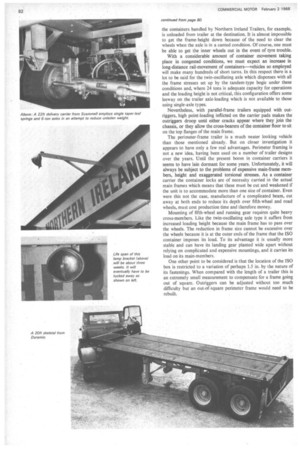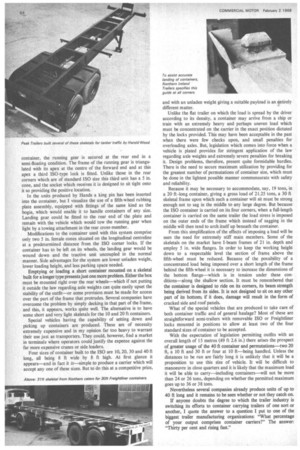Anatomy of the skeletal
Page 82

Page 83

Page 84

Page 85

Page 86

If you've noticed an error in this article please click here to report it so we can fix it.
R. D. Cater, AMInstBE examines the bare
bones of container-carrying trailer design
THE MOVE to containerization has not—contrary to what many people say—started only in recent years. In the transport of almost every commodity, it has been going on steadily since the early 1920s. Many are prejudiced on the grounds of the system's dangers of inflexibility. In days gone when retailers sold sugar, milk and tea loose, they also started off with a pessimistic view of packaged foods. "People do not all buy the same quantities of food", they warned.
It is perfectly true that not all transport movements are made in quantities suitable for standard size containers, that there is a degree of inflexibility in the system. And because of this inherent drawback, those concerned with container movements by road must seek to provide a higher degree of flexibility in the vehicles used for the job. The alternative is to have exorbitant capitalequipment costs sapping away hard-earned revenue.
One of the first points to be considered in container transportation concerns unladen weight. Of course, it would be wonderful if all one's vehicles were constructed to carry any size of container at any degree of loading possible. However, as hauliers are paid only for what they carry, so payload, containerized or otherwise, is still spelled E s d.
Although there are 22 companies engaged in the production of skeletal container carriers there are basically only five types available.
The most widely produced of these is the standard semi-trailer frame which instead of having cross-bearers to support a floor is equipped with outriggers upon which are carried the container locks. Makers employing twin-oscillating-axle running gear have secured something of an advantage in that their main frame is usually wider, enabling considerably shorter outriggers to be used.
Perimeter framing has been tried on standard semi-trailer equipment on and off for 20 years—it is a system which also has its advocates for skeletals. Only two novel ideas have been thrown up so far—one dispenses with the frame altogether and the other goes from the widest possible frame to the narrowest using a cruciform chassis. Both these systems have been devised by one company.
The first design mentioned has the dual advantages of low design costs and readily available production jigging. When talking to an operator about the suitability of different types recently, I learned that in fact this type has proved by far the best for his type of operation which covers some 2,000 container movements per week. Why had the design been suitable? Basically because it was cheap to buy and any damage inflicted on the locking devices is localized to the particular outrigger which can be fairly simply replaced.
The incidence of damage recorded by this company showed that by far the biggest cause of trailers being out of service was damage caused to locks when containers were lifted without the locks being properly released. Next came damage inflicted by collision with heavy dockside furnishings such as bollards, crane-gantries and the like. It might be thought that a vehicle in the congested conditions of a dock area would not be driven fast enough to do much damage, but in fact the expert drivers do move their machines quite quickly.
Although the shorter outriggers needed on the twin-oscillating-axle vehicles need not be quite so heavy as those with the narrow chassis, they are much more rigid than their longer counterparts, because they are shorter. While this characteristic is desirable from the point of view of the load-carrying qualities, it does promote the chances of main frame damage in the event of striking a fairly solid object. Furthermore there is little chance of the frame being lightened, for while the outriggers are shorter, the cross-members obviously are longer, making the material content of the unit much the same.
One problem that really bears down on the twin-oscillating-axle trailer is the frame height which makes the loading-height of the container excessive for loading or offloading—only I per cent of the containers handled by Northern Ireland Trailers, for example, is unloaded from trailer at the destination. It is almost impossible to get the frame-height down because of the need to clear the wheels when the axle is in a canted condition. Of course, one must be able to get the inner wheels out in the event of tyre trouble.
With a considerable amount of container movement taking place in congested conditions, we must expect an increase in long-distance rail-movement of containers—vehicles so employed will make many hundreds of short turns. In this respect there is a lot to be said for the twin-oscillating axle which dispenses with all the frame stresses set up by the tandem-type bogie under these conditions and, where 24 tons is adequate capacity for operations and the loading height is not critical, this configuration offers some leeway on the trailer axle-loading which is not available to those using single-axle types.
Nevertheless, with parallel-frame trailers equipped with outriggers, high point-loading inflicted on the carrier pads makes the outriggers droop until either cracks appear where they join the chassis, or they allow the cross-bearers of the container floor to sit on the top flanges of the main frame.
The perimeter-frame trailer is a much neater looking vehicle than those mentioned already. But on closer investigation it appears to have only a few real advantages. Perimeter framing is not a new idea, having been used on a number of trailer designs over the years. Until the present boom in container carriers it seems to have lain dormant for some years. Unfortunately, it will always be subject to the problems of expensive main-frame members, height and exaggerated torsional stresses. As a container carrier the container locks are of necessity carried in the actual main frames which means that these must be cut and weakened if the unit is to accommodate more than one size of container. Even were this not the case, manufacture of a complicated beam, cut away at both ends to reduce its depth over fifth-wheel and road wheels, must cost production time and therefore money.
Mounting of fifth-wheel and running gear requires quite heavy cross-members. Like the twin-oscillating axle type it suffers from increased loading height because the main frame has to pass over the wheels. The reduction in frame size cannot be excessive over the wheels because it is at the outer ends of the frame that the ISO container imposes its load. To its advantage it is usually more stable and can have its landing gear planted wide apart without relying on complicated and expensive mountings, and it carries its load on its main-members.
One other point to be considered is that the location of the ISO box is restricted to a variation of perhaps 1.5 in. by the nature of its fastenings. When compared with the length of a trailer this is an extremely small measurement to compensate for a frame going out of square. Outriggers can be adjusted without too much difficulty but an out-of-square perimeter frame would need to be rebuilt. The next design, which I referred to as being novel, comes from Hands Trailers Ltd. and features a new approach to the problem of carrying a load on the four outside corners of a vehicle.
The main frame of this model takes the shape of a cruciform and its makers claim that it represents the best method of absorbing the load stress into a frame. There are no torsional stresses applied to any member of the frame, each one being arranged so that only bending stress is applied. In all chassis frames there is an inherent tendency to whip and twist—to stop this would not only be expensive but also detrimental to its life span. The container, however, is extremely stiff and tends to load the whole of its weight diagonally across the corners if the carrier goes on to an uneven surface. It is under these conditions that most frame cracking occurs and it is easy to visualize one tiny outrigger on the narrow parallel frame having half the weight of a container imposed upon it.
So far a cruciform carrier has been constructed for carrying only one size of container. It is obvious that the shape does not permit several sets of locks to be mounted on each frame. So to utilize this type of vehicle one must, for the time being at any rate, use 20, 30 and 40 ft long models. It is likely that this design will be developed into an extensible type using the main centre-member only as a location to keep the alignment correct.
I mentioned that the fifth type of vehicle produced for container transport dispensed with a frame altogether. This system has also been devised by Hands Trailers and although the idea is not new, its application certainly is.
Because of the inherent rigidity of the ISO-type container it has been a practice in America for some years to attach running gear direct to the underside of the container. Both the Strick and Fruehauf organizations have produced equipment of this kind. However, the means of mounting the running gear has been crude to say the least, although it must be admitted that it has worked quite well. Road conditions in the UK are, as anybody who has used American-designed equipment knows, not conducive to loosely fitted gear giving long service. To cope with Britain's narrow and heavily cambered roads which have more bends than straights, running gear must be securely fitted and stay in accurate alignment at all times.
Hands has designed a fitting which, although quickly detachable, provides completely positive location for the running gear, and in my opinion this opens the door to the most efficient means of container operation. Not only does it offer complete flexibility in terms of the size of container handled, but it could also cut out a vast amount of capital involvement in the shape of spare trailer equipment. The snag with the system is that it needs some slight modifications to the container and any gains achieved in the production of less expensive trailers might be offset for some considerable time by the need for container modification.
By utilizing the existing ISO locks in the rear corners of the container, the running gear is secured at the rear end in a semi-floating condition. The frame of the running gear is triangulated with its apex at the centre of the forward end and at this apex a third ISO-type lock is fitted. Unlike those in the rear corners which are of standard ISO size this third unit has a 5 in. cone, and the socket which receives it is designed to sit tight onto it so providing the positive location. In the units produced by Hands a king pin has been inserted into the container, but I visualize the use of a fifth-wheel rubbing plate assembly, equipped with fittings of the same kind as the bogie, which would enable it to handle containers of any size. Landing gear could be fitted to the rear end of the plate and remain with the vehicle which would tow the running gear when light by a towing attachment in the rear cross-member.
Modifications to the container used with this system comprise only two 5 in. female cones situated on the longitudinal centreline at a predetermined distance from the ISO corner locks. If the container has to be left on its wheels, the landing gear would be wound down and the tractive unit uncoupled in the normal manner. Side advantages for the system are lower unladen weight, lower loading height, and less parking space needed.
Emptying or loading a short container mounted on a skeletal built for a longer type presents just one more problem. Either the box must be mounted right over the rear wheels—which if not putting it outside the law regarding axle weights can quite easily upset the stability of the outfit—or some provision must be made for access over the part of the frame that protrudes. Several companies have overcome the problem by simply decking in that part of the frame, and this, it appears, works quite well. The alternative is to have some short and very light skeletals for the 10 and 20 ft containers.
Special vehicles having the capability of setting down and picking up containers are produced. These are of necessity extremely expensive and in my opinion far too heavy to warrant their use just as transporters. They could, however, find a market in terminals where operators could justify the expense against the far more expensive cranes or side loaders.
Four sizes of container built to the ISO are 10, 20, 30 and 40 ft long, all being 8 ft wide by 8 ft high. At first glance it appears—and in fact it is—simple to produce a carrier which will accept any one of these sizes. But to do this at a competitive price, and with an unladen weight giving a suitable payload is an entirely different matter.
Unlike the flat trailer on which the load is spread by the driver according to its density, a container may arrive from a ship or train with an extremely heavy and perhaps uneven load which must be concentrated on the carrier in the exact position dictated by the locks provided. This may have been acceptable in the past when there were few checks upon, and small penalties for overloading axles. But, legislation which comes into force when a vehicle is plated provides for stringent application of the law regarding axle weights and extremely severe penalties for breaking it. Design problems, therefore, present quite formidable hurdles. There is the need to secure maximum utilization by providing for the greatest number of permutations of container size, which must be done in the lightest possible manner commensurate with safety and reliability.
Because it may be necessary to accommodate, say, 19 tons, in a 20 ft-long container, giving a gross load of 21.25 tons, a 30 ft skeletal frame upon which such a container will sit must be strong enough not to sag in the middle to any large degree. But because the ISO container is carried on its four corners, when a full-length container is carried on the same trailer the load stress is imposed on the outer ends of the frame which instead of sagging in the middle will then tend to arch itself up beneath the container.
From this simplification of the effects of imposing a load will be seen the need for extremely stiff main members. Some of the skeletals on the market have I-beam frames of 21 in. depth and employ 5 in. wide flanges. In order to keep the working height down to a respectable level the section of frame, above the fifth-wheel must be reduced. Because of the possibility of a concentrated load being imposed over a short length of the frame behind the fifth-wheel it is necessary to increase the dimensions of the bottom flange—which is in tension under these conditions—along the shallow section. It must be remembered that the container is designed to ride on its corners, its beam strength being derived from its sides. It is not designed to sit on any other part of its bottom; if it does, damage will result in the form of cracked side and roof panels.
What of the special vehicles that are produced to take care of both container traffic and of general haulage? Most of these are straightforward semi-trailers with removable ISO or Freightliner locks mounted in positions to allow at least two of the four standard sizes of container to be accepted.
With the expectation of legislation permitting outfits with an overall length of 15 metres (49 ft 2.6 in.) there arises the prospect of greater usage of the 40 ft container and permutations—two 20 ft, a 10 ft and 30 ft or four at 10 ft—being handled. Unless the distances to be run are fairly long it is unlikely that it will be a proposition to use this size of vehicle. It will be difficult to manoeuvre in close quarters and it is likely that the maximum load it will be able to carry—including containers will not be more than 24 or 26 tons, depending on whether the permitted maximum goes up to 36 or 38 tons.
Nevertheless several companies already produce units of up to 40 ft long and it remains to be seen whether or not they catch on.
If anyone doubts the degree to which the trailer industry is switching its efforts to container carrying trailers of one sort or another, I quote the answer to a question I put to one of the biggest trailer manufacturing organizations: "What percentage of your output comprises container carriers?" The answer: "Thirty per cent and rising fast."




































































































































































































